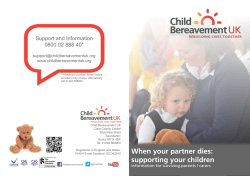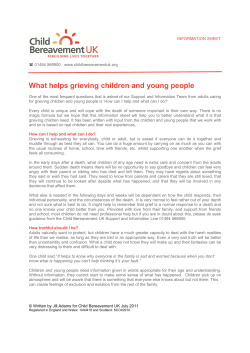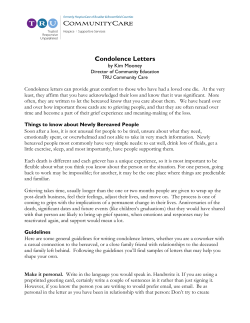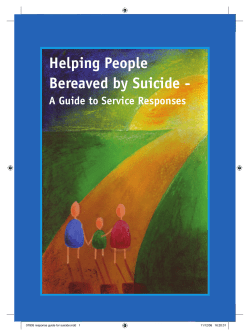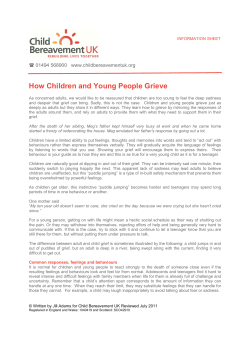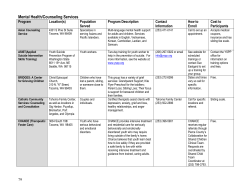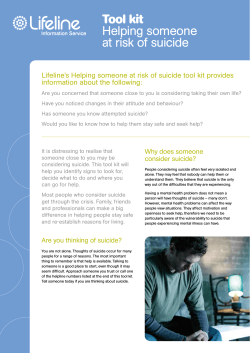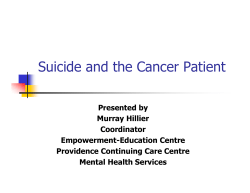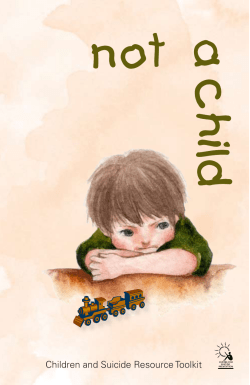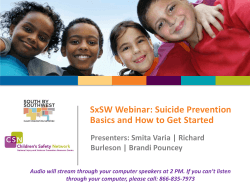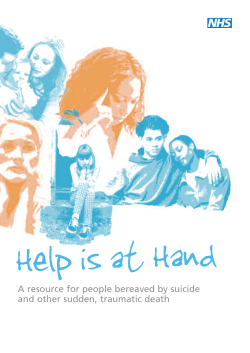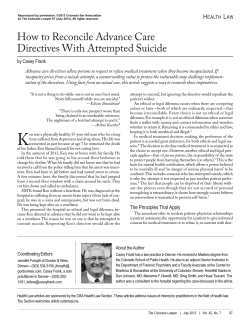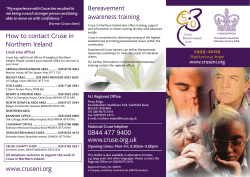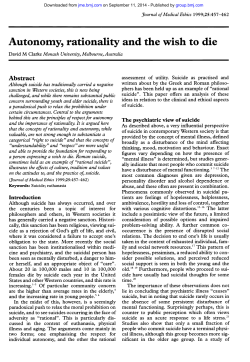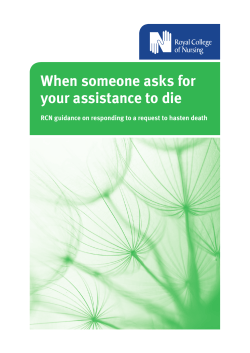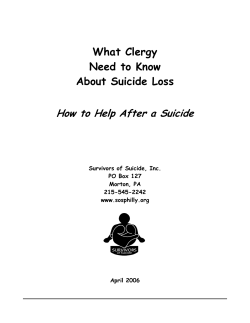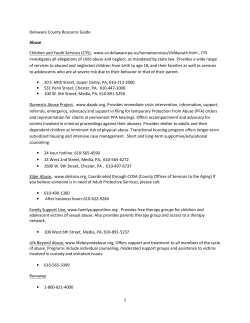
Young people bereaved by suicide: what hinders and what helps
INFORMATION SHEET 01494 568900 www.childbereavementuk.org Young people bereaved by suicide: what hinders and what helps Written by David Trickey Consultant Clinical Psychologist If you were to write out a list of “risk factors” that might be unhelpful to a bereaved young person, being bereaved by suicide often has them all. Research indicates that compared to children bereaved by nonsuicide deaths, children bereaved by suicide have greater anxiety, anger and shame in the year following 1 2 the death , and more symptoms of depression 18 months after the death . This article considers what is so bad about suicide for those young people left grieving and how they can be helped. What makes it particularly difficult for a young person to grieve after a suicide? Meaning Any death may be difficult to understand or make sense of. Even for an adult, a death may undermine 3 some basic beliefs about the world, beliefs that have come to be relied upon and considered truths . Children’s understanding in particular may be impeded by their limited understanding of death itself. Children develop their understanding of what death means depending on their cognitive ability and their experiences. Over time, children’s understanding of the concept of death, and their ability to deal with it, develops. This is extremely well described in Atle Dyregrov’s excellent book, Grief in Children: a Handbook for Adults4. But in general practitioners should not assume that children realise: that death is irreversible; that the body is no longer working, feeling or moving; that death is universal; precisely what caused the death; that the body will decompose; and that “bad things” may happen to “good people”. A death by suicide is likely to be even more difficult to understand. Answering the question “why?” may prove to be impossible and learning to live with not knowing may be the best outcome possible. In an attempt to try and explain the suicide, children (and adults) may assume that it was their fault in some way or that they could have done something to prevent it. This can lead to extreme guilt. This guilt can be even more severe in children if they have been involved in some way in the suicide and as noted earlier, research shows how children bereaved by suicide experience more shame than other bereaved children2. They may also assume that the deceased’s rejection of life is in some way also a rejection of them, which may lead to depression. Stigma In general, one of the ways in which people make sense of many of their experiences is to talk them through with those around them. However there continues to be a particular stigma attached to suicide, making it less talked about than other deaths. The absence of discussion means that children are sometimes denied opportunities to make sense of the event. They may not be told how the person died. Cain and Fast5 found in their sample of children bereaved by suicide that many of them who actually witnessed the suicide of their parent, were told by their surviving parent that the death was due to an accident or illness. Although this is an old study and hopefully things have changed, children continue to be denied information by adults, in the hope of protecting them. This may actually cause substantial problems for children if the account given to them does not tally with their knowledge of events, or what they overhear, or what they are told in the playground. They may be left to form their own account of what happened, in an attempt to make sense of the death. This made-up version of events may include the © Child Bereavement UK Author: David Trickey Written: Spring 2005 Reviewed: January 2012 Version No: 01 Registered in England and Wales: 1040419 and Scotland: SCO42910 idea that it was the child’s fault or that the dead person did not love them. At a time when they really need the adults around them to be trustworthy so at least something in life is dependable, they may be told lies. Furthermore if different adults in their lives have different ideas of what they should be told there may be splits and friction at a time when the child needs stability and peace. If children are initially given an untrue account, then it may cause problems as other adults in their lives may not know how to answer questions. Furthermore as time passes it may actually become more difficult to tell the truth not easier. The stigma attached to suicide can mean that children are not offered sources of support offered to other bereaved children. People sometimes feel that they do not know what to do or say, and therefore prefer to offer nothing. Families may feel that they have been failed by their GP and the mental health services who in their view “allowed the person to die”. They may therefore be reluctant to access such help for a bereaved young person. Children may worry that they might be prone to suicide as well. Police, procedures and press Suicide leads to the involvement of many strangers such as police officers, coroners and press. A family’s private grief may suddenly become a very public affair. Rather than being surrounded by those that the young person is close to, they may find themselves surrounded by complete strangers. If the suicide took place at home, it may suddenly become a potential “crime scene” and may lack its previous comforting ambience. Possessions can be removed by the police, including any suicide note. The procedures surrounding a suicide sometimes lead to a delay in the release of the body, which will delay the rituals that so often assist people with their grief. No warning The sudden nature of the death means that there is no opportunity to say goodbye, which can lead to greater disbelief for longer. There is also an increased risk of misuse of drugs and alcohol following bereavement by suicide. This means that those bereaved can stay numb for longer than those bereaved by other means, so by the time that the person does react, everyone has assumed that they are doing OK and support is no longer available. Memory Another way that people commonly make sense of experiences, including bereavements, is to think things through. However suicides are often violent deaths which can traumatise people, especially if they directly 6 witness the event or its aftermath. Shepherd and Barraclough found that almost half of their sample of children was close by at the time of the suicide. This traumatisation “trips up” the usual grieving process because each time the bereaved brings the deceased to mind the graphic vivid image of the death takes precedence over any other softer more pleasant memories7. The person may dread thinking about the deceased person and avoid it wherever possible. This makes grieving very difficult. What can help? Children and young people do not need to know every detail immediately, but bearing in mind that they may read details in the paper, or hear details in the playground, it is less damaging for them to be told a truthful account of what happened by someone that they already know and trust, who is able to tell the truths in a way that takes into account their age, maturity and enables them to ask questions. This may be very distressing or shocking for the child and they may not take it all in the first time, therefore information may need to be repeated. They need the opportunity to talk and to ask questions, but no pressure to do so. The child may also need help to weave the information into a “story” that makes sense to them. Being in an environment where it is acceptable to talk of the deceased and how they died, will assist with this process. A coherent story that explains the facts will facilitate their grief. The story should also enable the child or young person to explain what has happened to curious peers, and protect them to a certain extent from the taunts of unkind peers. If a number of siblings have been bereaved the story should be one that is shared, although older siblings may have a more mature and fuller understanding. A possible story that might be told to young children bereaved by suicide is that the deceased had a “mind-sickness”. (Given that it is estimated that 90% of adults who kill themselves are thought to have 8 been suffering from mental illness this is not an unreasonable explanation) Children understand that when they are sick something in their body is not working properly, so the idea that the person’s mind was not working properly may help to explain their actions. The story can go on to explain that the mind sickness meant that the person was not thinking properly so they thought that it would be better if they were dead. This is not true - they were mistaken because their mind was not working properly. So they hurt themselves so badly that the doctors could not make them better and they died. This story has been 9 found very useful by Dora Black , it is apparently the original idea of Erna Furman, but I cannot find a publication containing it. © Child Bereavement UK Author: David Trickey Written: Spring 2005 Reviewed: January 2012 Version No: 01 Registered in England and Wales: 1040419 and Scotland: SCO42910 As they mature they may require more information and may be able to handle more details. The story may need elaborating to incorporate new information and their more mature understanding. Explaining a death that is as traumatic as suicide is likely to be a process rather than an event. Adult family members may need help to do this with children and young people, and clinicians can offer appropriate support before, during and after, as required. On some occasions the clinician may be the best adult to actually tell the child or young person what happened and answer their questions, but generally it is better if someone that the child already knows is able to do this. Problem solving There may be little that can be done to minimise the impact of police, procedures and press, although sometimes just the process of listening to the family’s difficulties decreases their distress or enables them to begin to problem solve more effectively. One mother with whom I worked was suddenly unable to make simple decisions concerning her children. My role here was not to make the decisions for her, but to reassure her that she was as good a parent this week as she had been last week, and to help her to think things through and make the decisions herself. Rituals Rituals are concrete ways of expressing complex and intense feelings. Sometimes children or young people are denied access to such rituals, when they are probably the people who would most benefit from such a concrete expression of emotion. There is much written about children’s involvement in rituals with 4 Atle Dyregrov’s book being one of the most readable and comprehensive . Counselling Although the environment around children and young people has a great deal to offer in terms of assisting with their grief, individual counselling may also be useful. It can offer the person the opportunity to express any thoughts or ideas they may have that would be unbearable even for the most supportive of families. Counsellors are able to tolerate and contain the young person’s distress in a way that other adults in the person’s life may not be able to, possibly because they are also shocked and distressed. Counselling can provide the young person with opportunities to think about ways to deal with their distress more effectively than following the deceased. Counselling offers a judgement-free environment in which to express all their feelings, including relief, and feeling guilty about not feeling guilty. Guilt is such a common feeling following a suicide, that counsellors should specifically ask the child or young person what they think may have lead the person to kill themselves. This allows the counsellor to assess whether the young person feels responsible and it opens up conversations which can help the young person to re-evaluate the unhelpful beliefs which lead to feelings of guilt. There is an understandable concern that someone bereaved by suicide may be more at risk of committing 4 suicide. The research is somewhat mixed in this area, but there is some evidence of an increased risk . Counsellors should therefore be more aware of their client’s potential for suicidality. With adolescents particularly they should specifically ask how bad their clients have felt and enquire if they have had any suicidal thoughts. Silva and Cotgrave examined suicide in bereaved youths, and suggested that 10 counsellors should be aware of the risk factors for adolescent self-harm and suicide . They provide the following as an aide-memoire: depressed mood, recent change in behaviour, history of self-harm, history of mental illness, threats of self-harm, substance abuse, impulsivity, hostility, deteriorating support, legal problems. If a counsellor considers that their client is at risk of suicide, they should contact the client’s GP 11 or seek a mental health consultation. In Parkes’ important article , the advice is clear: “it is the responsibility of the counsellor to do his or her best to prevent suicide even if this necessitates a breach of the confidential relationship between counsellor and client”. Timing Making contact with a child or young person and possibly their family at an early stage, enables the counsellor to give information about the help that is available, and may make it easier for the young person to make contact at a later stage when they feel that they may need it. My involvement with traumatically bereaved families often has a number of phases. Initially, in the immediate aftermath, I may be involved with the family, sometimes just the adults, helping them to create the most therapeutic environment around the child or young person. I may then fade into the background and allow the family to move on together without my interference, knowing that they can contact me if they would like to in the future. Then sometimes 6 months later, there is some problem which leads the family to consider that the young person is still struggling with their grief and they approach me for some further help. This may take the form of some individual work with the young person. Then at some much later stage, an event may trigger further feelings and difficulties, and the family find it easy to approach me again, because they feel that I know them already and they will not have to explain the whole situation from scratch to a stranger. © Child Bereavement UK Author: David Trickey Written: Spring 2005 Reviewed: January 2012 Version No: 01 Registered in England and Wales: 1040419 and Scotland: SCO42910 Group peer interventions Group therapy can be particularly helpful for children and young people who are traumatised by suicide. Just the process of hearing other people’s stories immediately makes the young person realise that they 12 are not alone in their wretchedness . Peers who had similar experiences sometimes make for much more potent therapists than adult counsellors who may be perceived by the young person as being out of touch. Pfeffer and colleagues have developed a manualised group intervention for children bereaved by suicide. This intervention encourages discussion of death and its permanence; it assists children to identify feelings of grief, facilitates discussion of suicide and suicide prevention and enhances problem solving. There is a parallel parental component to the intervention. It has been shown to decrease symptoms of 13 anxiety and depression . www.rd4u.org.uk is part of Cruse Bereavement Care's Youth Involvement Project. It is a website designed for bereaved young people by bereaved young people and is a place where peers can swap stories and offer each other support. Available resources There are many resources available to traumatically bereaved young people, many of which have been reviewed here in Bereavement Care, and families should be encouraged to seek this help out, rather than to hide in shame. In particular Winston’s Wish is extremely helpful. It offers phone advice, guidance and support on 0845 20 30 40 5. The website is excellent (www.winstonswish.org.uk), and it also includes an area specifically for young people. Furthermore Winston’s Wish has produced an excellent booklet entitled “Beyond the Rough Rock: Supporting a Child who has been Bereaved through Suicide” which offers practical advice to families. SOBS (Survivors Of Bereavement by Suicide) is a voluntary self help organisation that offers support through: telephone contacts, bereavement packs, group meetings (in a number of locations), one-day conferences, residential events and information relating to practical issues and problems. The website is www.uk-sobs.org.uk and the phone number is 0844 561 6855. Conclusion Research has not consistently demonstrated that a young person’s bereavement after a suicide is 14 particularly different in quality to other bereavements . The actual effects are similar, but stronger and longer. There are particular elements of such a death that may act as obstacles to grief. Therefore what a young person needs is just the same as any other bereaved young person - but probably just more of it providing some additional support to get over the obstacles. 1. Cerel J, Fristad MA, Weller EB, Weller RA. Suicide-Bereaved Children and Adolescents: A Controlled Longitudinal Examination. Journal of the American Academy of Child and Adolescent Psychiatry 1999; 38(6): 672-679 2. Pfeffer CR, Karus D, Siegal K, Jiang H. Child Survivors of Parental Death from Cancer or Suicide: Depressive and Behavioral Outcomes. Psycho-Oncology 2000; 9: 1-10 3. Smith-Landsman I. Crises of Meaning in Trauma and Loss. In: Kauffman J (ed). Loss of the Assumptive World: A Theory of Traumatic Loss. New York & London: Brunner-Routledge, 2002. © Cruse Bereavement Care 2005 4. Dyregrov A. Grief in Children: A Handbook for Adults. London & Bristol, Pennsylvania: Jessica Kingsley Publishers, 1991. 5. Cain AC, Fast I. Children’s Disturbed Reactions to Parental Suicide. American Journal of Orthopsychiatry 1966; 47: 196-206. 6. Shepherd DM, Barraclough BM. The Aftermath of Parental Suicide for Children. British Journal of Psychiatry 1976; 129: 267-276. 7. Raphael B. The Interaction of Trauma and Grief. In Black D, Newman M, Harris-Hendriks J, Mezey G (eds). Psychological Trauma: A Developmental Approach. London: Gaskell, 1997. 8. Barraclough B, Bunch J, Nelson B, Sainsbury P. One hundred cases of suicide: clinical aspects. British Journal of Psychiatry 1974; 25: 355-373. 9. Black personal communication 10. Silva, E, Cotgrave A. Youth suicide and bereavement. Bereavement Care 1999; 18(1): 11. Parkes, CM. The risk of suicide after bereavement. Bereavement Care 1982; 1(1): 4-5. 12. Yalom, I. The Theory and Practice of Group Psychotherapy. New York: Basic Books Inc., 1985. 13. Pfeffer CR, Jiang H, Kakuma T, Hwang J, Metsch M. Group Intervention for Children Bereaved by the Suicide of a Relative. Journal of the American Academy of Child and Adolescent Psychiatry 2002; 41(5): 505-513 14. Cerel J, Fristad MA, Weller EB, Weller RA. Suicide-Bereaved Children and Adolescents: II. Parental and Family Functioning. Journal of the American Academy of Child and Adolescent Psychiatry 2000; 39(4): 437-444 © Child Bereavement UK Author: David Trickey Written: Spring 2005 Reviewed: January 2012 Version No: 01 Registered in England and Wales: 1040419 and Scotland: SCO42910 Written by David Trickey, Consultant Clinical Psychologist Reproduced from Bereavement Care Spring 2005; 24(2): 11-14 by kind permission of Cruse Bereavement Care, 126 Sheen Road, Richmond TW9 1 UR, UK. Reproduced from Bereavement Care Spring 2005; 24(2); 11-14 by kind permission of Cruse Bereavement Care, 126 Sheen Road, Richmond TW9 1UR, UK. © Cruse Bereavement Care 2005 © Child Bereavement UK Author: David Trickey Written: Spring 2005 Reviewed: January 2012 Version No: 01 Registered in England and Wales: 1040419 and Scotland: SCO42910
© Copyright 2025
